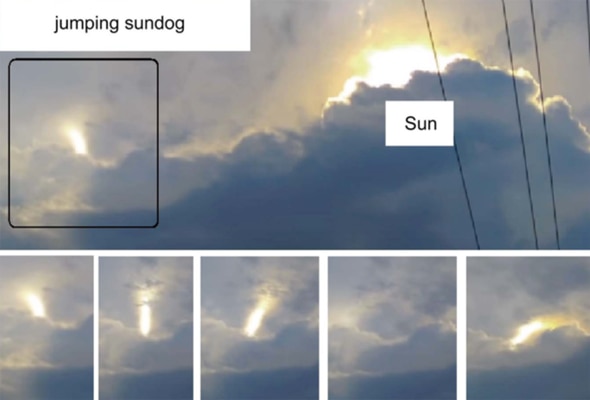Create a free profile to get unlimited access to exclusive videos, sweepstakes, and more!
Ice Crystals Above Clouds Dance to the Tune of Electricity

A few years ago I wrote an article about one of the most bizarre phenomena I had ever seen: dancing, twisting beams of light appearing over storm clouds. The video of them is really weird. Watch:
It looks like the cloud itself is writhing!
After I saw the video, I contacted a meteorologist I knew, and he was able to find the probable cause.
First, clouds can generate enormous electric fields, generally due to rising and falling ice crystals rubbing against each other. The charges separate, and if enough of them build up, they reconnect electrically—via lightning. A typical bolt of lightning can have tens of thousands of amps of current flowing, which is a lot.
Sometimes, long, needlelike ice crystals form in the air above a cloud. They can get an electrostatic charge, like when you rub a balloon against your hair. When they do, they tend to align themselves along the electric field of the cloud. When a lightning bolt discharges, the electric field of the cloud changes suddenly. This changes the orientation of the ice crystals all at once, so what you see is a flash of light whipping around. The general name for this effect is a crown flash (though it’s sometimes called a jumping sundog; “sundog” is itself a nickname for parhelia, bright spots 22° away from the Sun and parallel to the horizon, caused by ice crystals reflecting sunlight).
At least, this is what has been supposed. A new paper in the open-access Journal of Applied Mathematics and Physics put this to the test. They modeled the ice crystals using a ferrofluid, mineral oil with tiny iron-based nanoparticles suspended in it. When a magnetic field is applied, the particles line themselves along it, forming bizarre and lovely shapes. Here’s a cool video (unrelated to the cloud research) showing how they work:
In this new work, the scientists bounced a laser (representing sunlight) off a ferrofluid, and showed that the direction in which the beam got reflected changed as they repositioned the magnet, and it happened in a similar way as the real crown flashes above clouds. While this doesn’t prove the proposed explanation, it strongly supports it, and I find this hypothesis pretty compelling.
I’ve never seen a crown flash myself; they’re pretty rare, and the geometry has to be just right to create them. Maybe someday.
But I do get a consolation prize. The reason I heard about this research is that I was notified by the paper’s lead author Alberto Tufaile on Twitter. It turns out he found out about the phenomenon by reading my article on it! He and his team even reference it in the paper:
(That was from when my blog was hosted by Discover Magazine, if you’re curious; I moved to Slate in 2013.)
How cool is that? I don’t think my blog has ever been cited in a science paper before, much less been the starting point for the research itself! And, why yes, before you ask, I am pretty chuffed with myself over that.
But the real takeaway here is that there is stuff going on literally right over our heads that we still don’t fully understand, and may not even know about yet. So—and I bet you know what I’m about to say here:
Look up! You never know what you might see.


























